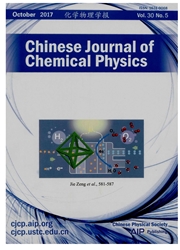

 中文摘要:
中文摘要:
利用G3和CBS—QB3的理论方法研究CF30H分子裂解成FCFO和HF,并考虑大气中双分子和氨气对CF30H分子裂解的催化作用.理论计算表明:由于在G3的理论水平下,计算的能垒为188.52kJ/mol,所以CF3OH分子在大气条件下不可能发生单分子裂解;当氨气和双分子水被加入时,能垒都被降到25.08kJ/mol,起了强的催化作用.除此之外,应用过渡态理论对速率常数进行了计算,计算结果表明:氨气催化CF3OH分子的速率常数是单分子和双分子催化CF3OH分子裂解速率常数的100和100倍.考虑到大气中这些物质的浓度,计算结果预测了氨气催化CF3OH分子裂解在大气中起到重要的作用.
 英文摘要:
英文摘要:
The G3 and CBS-QB3 theoretical methods are employed to study the decomposition of CF3OH into FCFO and HF by water, water dimmer, and ammonia. The decomposition of CF3OH into FCFO and HF is unlikely to occur in the atmosphere due to the high activated energy of 88.7 k J/mol at the G3 level of theory. However, the computed results predict that the barrier for unimolecular decomposition of CF3OH is decreased to 25.1 kJ/mol from 188.7 k J/mol with the aid of NH3 at the G3 level of theory, which shows that the ammonia play a strong catalytic effect on the split of CF3OH. In addition, the calculated rate constants show that the decomposition of CF3OH by NH3 is faster than those of H2O and the water dimmer by 10^9 and 10^5 times respectively. The rate constants combined with the corresponding concentrations of these species demonstrate that the reaction CF3OH with NH3 via TS4 is of great importance for the decomposition of CF3OH in the atmosphere.
 同期刊论文项目
同期刊论文项目
 同项目期刊论文
同项目期刊论文
 期刊信息
期刊信息
